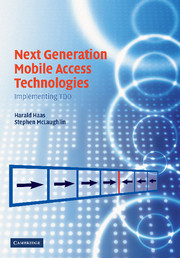Book contents
- Frontmatter
- Contents
- List of abbreviations
- Acknowledgements
- 1 Introduction
- 2 Wireless telecommunications using CDMA and TDD techniques
- 3 Interference and capacity analyses
- 4 Centralised DCA algorithm using the TS-opposing idea
- 5 Distributed DCA algorithm utilising the TS-opposing idea
- 6 UTRA-TDD Opportunity-Driven Multiple Access (ODMA)
- 7 Routing strategies in multi-hop CDMA networks
- 8 Multi-hop DCA
- 9 Radio resource metric estimation
- 10 Interference-based cancellation techniques for TDD
- 11 Smart Antennas for TDD-CDMA Systems
- 12 Cellular OFDMA-TDD
- 1 Derivation of T: Unconstrained Optimisation
- Bibliography
- Index
3 - Interference and capacity analyses
Published online by Cambridge University Press: 02 September 2009
- Frontmatter
- Contents
- List of abbreviations
- Acknowledgements
- 1 Introduction
- 2 Wireless telecommunications using CDMA and TDD techniques
- 3 Interference and capacity analyses
- 4 Centralised DCA algorithm using the TS-opposing idea
- 5 Distributed DCA algorithm utilising the TS-opposing idea
- 6 UTRA-TDD Opportunity-Driven Multiple Access (ODMA)
- 7 Routing strategies in multi-hop CDMA networks
- 8 Multi-hop DCA
- 9 Radio resource metric estimation
- 10 Interference-based cancellation techniques for TDD
- 11 Smart Antennas for TDD-CDMA Systems
- 12 Cellular OFDMA-TDD
- 1 Derivation of T: Unconstrained Optimisation
- Bibliography
- Index
Summary
Introduction
A special property of the TDD mode is that not only the mobile stations (MSs) can interfere with the base stations (BSs), but also the MSs may interfere with each other. The same holds for BSs, which can interfere with MSs as well as other BSs. This property of a TDD interface creates complex interference situations. The resulting interference has a significant impact on capacity. In this chapter, other-cell interference including adjacent-channel interference (ACI) and co-channel interference (CCI) are examined. In this context, multi-operator scenarios are considered since in UMTS (Universal Mobile Telecommunications System), for instance, any one operator may only obtain a single TDD carrier.
In order to assess the impact of interference on capacity (the number of users that can be served simultaneously), in section 3.2 a new equation is derived to calculate the system capacity relative to the non-interfered state (a single, isolated cell). In addition, the pole capacity (the theoretical upper bound of capacity) is calculated for the case of ideal power control and non-ideal power control.
In section 3.3 ACI is studied in single-cell and multiple-cell environments. The probability density function (pdf) of interference in the single-cell environment is derived analytically in order to validate the simulation platform. In the multiple-cell environment the effects of handover and power control on interference and capacity, respectively, are examined.
In section 3.4 CCI is analysed with a special focus on distribution of interference with respect to the basic interference sources: MSs and BSs.
- Type
- Chapter
- Information
- Next Generation Mobile Access TechnologiesImplementing TDD, pp. 54 - 94Publisher: Cambridge University PressPrint publication year: 2008



